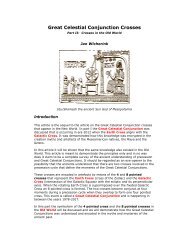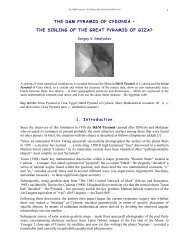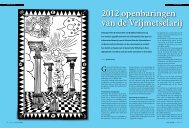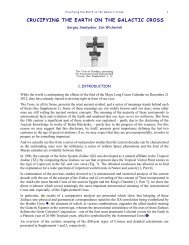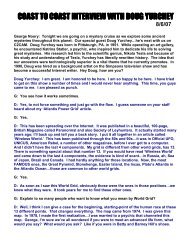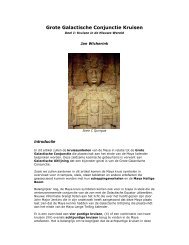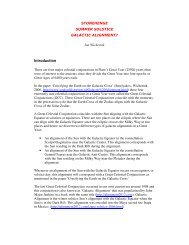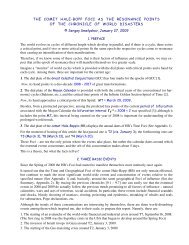Appendix MARS AND D&M PYRAMID ... - Souls of Distortion
Appendix MARS AND D&M PYRAMID ... - Souls of Distortion
Appendix MARS AND D&M PYRAMID ... - Souls of Distortion
You also want an ePaper? Increase the reach of your titles
YUMPU automatically turns print PDFs into web optimized ePapers that Google loves.
<strong>Appendix</strong> to “The D&M Pyramid – the Sibling <strong>of</strong> the Great Pyramid <strong>of</strong> Giza?” 3<br />
A4. D&M Pyramid Geographical Coordinates<br />
Viking orbiter frames show that the D&M Pyramid is located at 40.65N 9.55W. All three frames were<br />
taken close to periapsis and yield a pixel resolution <strong>of</strong> ~50 m [3]. The later images from MGS MOC and<br />
from the Mars Odyssey camera give the same (in round figures) location: “near 40.7° N, 9.6° W” [19].<br />
So, we can accept the following geographical coordinates for the D&M pyramid<br />
ψ D = 40.65° N (or 40° 39’ N), l D = 9.55° W (or 9° 33’ W). [3]<br />
A5. D&M Pyramid Geometry<br />
A5.1. A synopsis <strong>of</strong> Erol Torun’s reconstruction [3] <strong>of</strong> the D&M pyramid geometry<br />
In exploring the geometry <strong>of</strong> the D&M Pyramid, the most conservative approach possible was pursued.<br />
Study <strong>of</strong> the D&M Pyramid's geometry was therefore restricted to overall observations <strong>of</strong> location and<br />
symmetry, and to some relationships.<br />
The D&M Pyramid shows signs <strong>of</strong> being damaged on one side, perhaps by a meteoric impact. Some edge<br />
and angle reconstruction was therefore necessary before any accurate measurements could be obtained.<br />
This is a speculative reconstruction, due to the eroded state <strong>of</strong> the object. The reconstructive technique is<br />
however the same as that used widely in archaeology when evaluating sites in which geometry is<br />
important, as in archaeoastronomy.<br />
An NGF filtered orthographic negative <strong>of</strong> Viking orbiter frame 70A13 was obtained from the National<br />
Space Sciences Data Center. An orthographic projection was necessary to ensure that the geometry <strong>of</strong> the<br />
object under study was accurately represented on the image.<br />
The negative image <strong>of</strong> the D&M was projected using a photographic enlarger that had first been<br />
calibrated with a projection grid. This image was used for the reconstruction, combined with reference to<br />
an unrectified image processed by Dr. Mark Carlotto for confirmation <strong>of</strong> detail that was sometimes less<br />
clear in the contrasty original negative.<br />
1. The most distinct edges on the pyramid, those on the sunlit side, were marked by visual averaging.<br />
These edges were extended to locate the position <strong>of</strong> the hypothetical original apex.<br />
2. A straight line was drawn from the apex through the flat protuberance at the front <strong>of</strong> the pyramid to<br />
mark what appears to be an axis <strong>of</strong> symmetry.<br />
3. A line was extended from the apex to the right front corner, which is sharp and clearly visible on the<br />
Carlotto image.<br />
4. The figure was enclosed, based upon the left side <strong>of</strong> the pyramid and the right front corner.<br />
All visible angles <strong>of</strong> the D&M Pyramid were measured (+/- 0.2 deg) and subjected to the tests mentioned<br />
earlier: radian measure, angle ratios, and trig functions.<br />
The reconstructed geometry <strong>of</strong> the D&M Pyramid shows a five-sided object which has bilateral<br />
symmetry, with a pair <strong>of</strong> congruent angles forming the front, and another pair <strong>of</strong> congruent<br />
angles forming the sides. In this illustration the arrow points along the axis <strong>of</strong> bilateral symmetry.<br />
The five-sidedness, bilateral symmetry, and primary alignments were first observed by Richard Hoagland<br />
after studying quality digital enlargements prepared in 1984 by SRI International from negatives <strong>of</strong><br />
images processed by DiPietro and Molenaar.<br />
The angles formed by the D&M Pyramid when viewed from above differ from each other. Consequently,<br />
they can form various ratios. These angle ratios were studied to see if the values were significant, or<br />
merely random.<br />
A table has been prepared displaying a list <strong>of</strong> the measured angles, and the results <strong>of</strong> the analysis. The<br />
square roots <strong>of</strong> three and five, and the values <strong>of</strong> e and pi predominate. The identity <strong>of</strong> these values is<br />
strengthened by the numerous combinations in which they occur.





